


FINANCIAL PROFESSIONALS ONLY
U.S. Small-Cap Market Overview
September 30, 2025


Table of Contents
5Year-to-Date Small-Cap Overview as of 9/30/25
63Q25 Sector and Industry Review
7Year-to-Date Sector and Industry Review
8Small-Cap Recoveries Since 1945
9Small-Caps Near Historic Low Versus Large-Caps
10Small-Cap Significantly Cheaper than Mid- and Large-Cap Size Segments
12Historically Small-Cap Cycles Have Averaged More Than a Decade
13Small-Cap’s Weight in the Russell 3000 Is Below Historical Low
14Large-Cap Cycles Peak at Market Tops Crowded with Mega-Caps
15Relative Valuations for Small-Caps vs. Large-Caps are Still Below Average
17Missing the Rally’s Earliest Stage Has Been Costly
18Small-Cap’s Estimated Earnings Growth is Expected to Be Higher Than Large-Cap’s in 2025
19Average Expected Earnings Growth for 2025-2026
20When the Equal-Weighted Russell 1000 Outperformed, Small-Cap Generally Led
21High-Quality and Low-Quality Small-Cap Stocks Have Historically Had Different Performance Profiles

Market Overview
U.S. small-cap equities delivered strong gains in the third quarter of 2025, extending their recovery from earlier in the year and benefiting from a broadening of market leadership beyond the mega-cap technology names. The Russell 2000 Index advanced solidly, with the Russell 2000 Value Index slightly outpacing the Russell 2000 Growth Index—up roughly 12.6% versus 12.2%—though growth stocks led over the longer stretch going back to early spring. A more dovish Federal Reserve tone and growing investor appetite for attractively valued companies helped fuel the rally, while easing inflation pressures supported confidence in smaller, more domestically focused businesses.
Year-to-date through the end of the third quarter, small caps have participated meaningfully in the broader equity rally, though results remain uneven across sectors and styles. Select high-growth and niche names have delivered outsized returns, while many companies with stronger balance sheets or cyclical exposure have lagged. Improved earnings trends and expectations for lower borrowing costs have helped restore investor confidence, particularly in quality-focused small-cap companies with durable growth drivers.
Looking ahead, the backdrop for small-caps appears more favorable than it has in several years. Attractive relative valuations, stabilizing inflation, and the potential for lower interest rates could support continued outperformance, particularly if economic growth remains resilient. However, risks persist—especially around earnings execution and funding conditions. With dispersion remaining high, stock selection is critical, and active, fundamentals-driven strategies emphasizing strong balance sheets, sustainable margins, and consistent profitability may be best positioned to capture ongoing opportunities in this phase of the small-cap cycle.
3Q25 Small-Cap Overview
The highest returns went to the smallest stocks during 2025’s third quarter—the Russell 2000 Index advanced 12.4% versus an 8.0% gain for the Russell 1000 Index, a decisive, and long-awaited, advantage for small-cap stocks. The quarter saw value out perform growth, high leverage outperform low leverage, the lowest profitability companies outperform the highest, and dividend payers underperform non-dividend payers.



Year-to-Date Small-Cap Overview as of 9/30/25
For the year-to-date period ended 9/30/25, large-caps held their performance advantage: the Russell 2000 rose 10.4% versus 14.6% for the Russell 1000. Micro-caps, however, outpaced large-caps, rising 15.7% (while the mega-cap Russell Top 50 gained 16.5%). In the small-cap asset class, two other areas stood out: growth performed better than value and the lowest ROIC companies outperformed the highest by over 500 basis points.

3Q25 Sector and Industry Review
All of the Russell 2000’s sectors positively contributed to performance for the quarter, led by Materials, Industrials, and Communication Services. Real Estate, Financials, and Consumer Staples contributed the least for the quarter.

Year-to-Date Sector and Industry Review
Year-to-date, Materials, Industrials, and Utilities led the Russell 2000 through the end of the September, while Real Estate and Consumer Staples contributed the least. Energy was flat for the period.

Small-Cap Recoveries Since 1945
Since 1945, small-cap stocks have historically rebounded strongly after declines of 15% or more, often leading the broader market in subsequent recoveries.


Small-Caps Near Historic Low Versus Large-Caps

Small-Cap Significantly Cheaper than Mid- and Large-Cap Size Segments
Four observations leap out when comparing various segments of the U.S. equity market as represented below by the Russell Indexes: 1) Small-Cap Value and Small-Cap Core are the cheapest segments of U.S. equities, 2) these segments are the only ones slightly above their 25-year average valuation, 3) while all three value segments (Small-Cap, Mid-Cap, and Large-Cap) have very similar 25-year average valuations, their current valuations are vastly different, and 4) Mid-Cap Growth, Large-Cap Growth, and overall Large-Cap valuations still have a long way to fall to reach their 25-year average valuations.


Historical Perspective
Sky-high valuations for U.S. equities have been the subject of many commentaries over the last few years. We think it’s important to point out, however, that most of these observations have focused on larger stocks, whether discussing the Magnificent 7 (Alphabet, Amazon, Apple, Meta, Microsoft, Nvidia, and Tesla), the Nasdaq 100, or the S&P 500. In our view, small-cap stocks remain far more reasonably valued than their larger cousins, who have received the lion’s share of the attention regarding valuations.
Two examples help explain our contention that small-cap stocks as a group are still attractively valued. The first is that the Russell 2000 as a percentage of the Russell 3000 Index has historically averaged 7.6% since late 1984. Yet even after the robust uptick off the April lows, the Russell 2000’s weight was 4.4% at the end of September, significantly below that long-term average. Our second observation is that valuations for the Russell 2000 remained attractive relative to the Russell 1000 based on our preferred index valuation metric of EV/EBIT or enterprise value over earnings before interest and taxes.
It’s a challenging exercise during the best of times, but as we look through the noise and think about the long run, we see many small-cap companies with excellent fundamentals and/or strong prospects for long-term growth or recovery that are also selling at attractive prices. To be sure, our investment teams are busy searching for promising bargains, knowing that many investors are not looking at financial and operational fundamentals and/or don’t have long-term investment horizons similar to our own.
At the same time, many small-caps stocks are emerging from a two-year earnings recession, which should help boost performance for the currently lagging, low expectation small-cap asset class. We would further remind our readers that periods of low expectations and relatively underwhelming returns have often been opportune times at which to increase allocations. Missing the early stage of a rally has carried a high cost in previous recoveries.
Historically Small-Cap Cycles Have Averaged More Than a Decade
Secular changes in economic trends, interest rates, and monetary and fiscal policies continue to alter the long-term investment landscape. The winners under the past decade’s zero interest rate, low inflation, and low nominal growth regime will no longer lead. The unfolding macro environment points to the small-cap asset class being able to sustain, not just tactically outperform, large-cap.

Small-Cap’s Weight in the Russell 3000 Is Below Historical Low
Small-cap’s underperformance versus large-cap has reached such an extreme point that small-cap’s weight in the Russell 3000 sits at historical lows not seen since the early 1990s, another indicator suggesting that a sustained small-cap rebound may be coming.


Large-Cap Cycles Peak at Market Tops Crowded with Mega-Caps
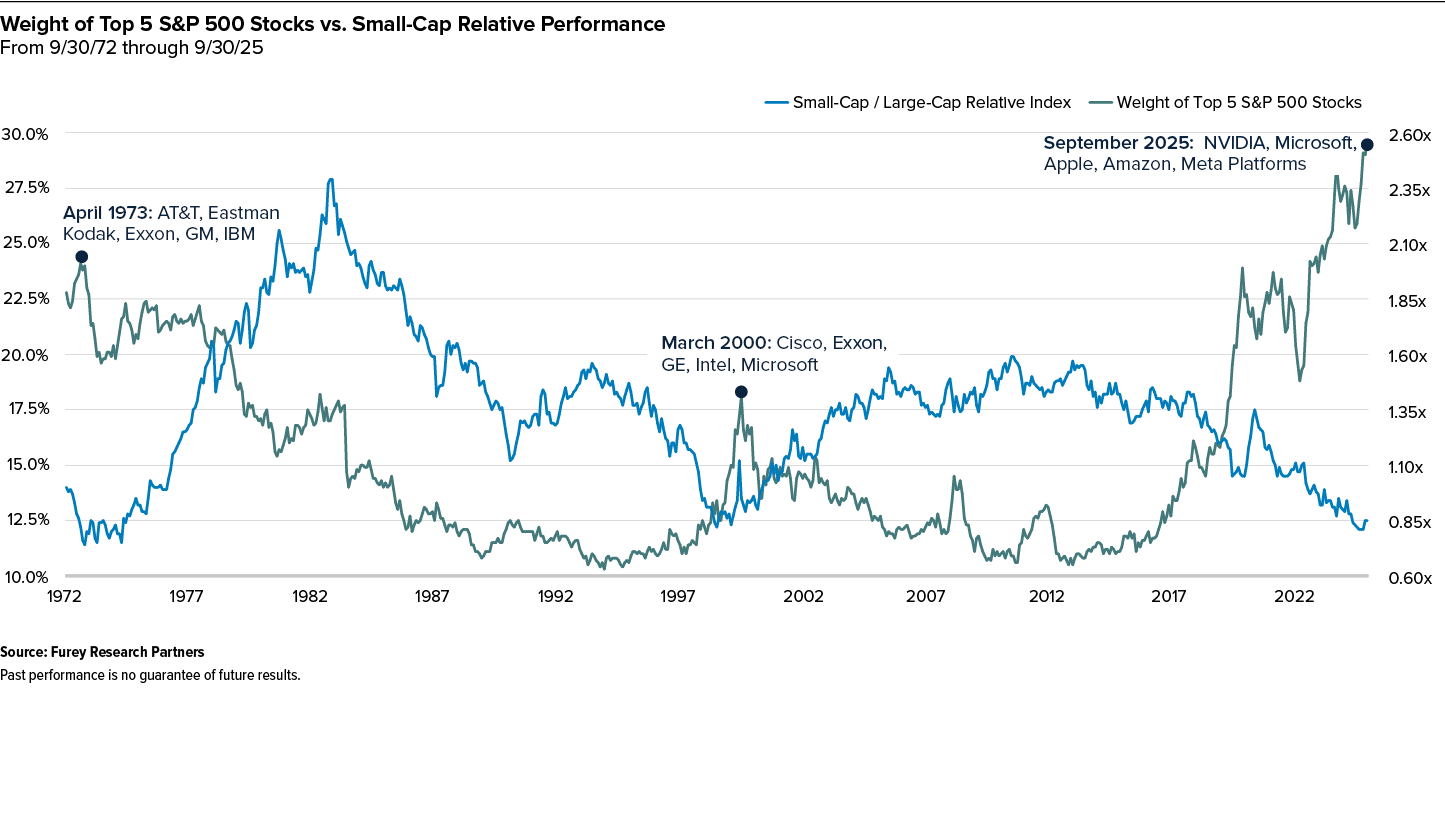

Relative Valuations for Small-Caps vs. Large-Caps are Still Below Average
Even with the most recent outperformance, the Russell 2000 remains extremely undervalued compared to its relative valuation range over the past 25 years.

Small-Cap Market Outlook
We remain confident about the long-term prospects for our chosen asset class. When looking ahead, there’s always far more that we don’t know than we do. Even the best-informed and data-driven observations involve some guesswork. We always think that history is a useful guide, while also being mindful that each historical period comes with its own context; similar conditions may yield markedly different results. And needless to say, our current situation has more than its share of sizable unknowns. The U.S. government is closed. The U.S. consumer continues to spend, but confidence continues to trend downward. The state of geopolitics remains fraught with dangers and risks. Earnings season began in October and guidance will be even more crucial than usual (and it’s never less than crucial) given the high level of uncertainty surrounding tariffs. There are also bright spots: the effects of reshoring, reindustrializing, and infrastructure improvements have not yet reached their respective ends. As we mentioned above, both the capital markets and economy proved remarkably resilient throughout the challenging first half of 2025.
Against this backdrop, we are confident in what we do know—and small-cap stocks are what we know best. As of the end of September, the Russell 2000 remained much less expensive than the Russell 1000. Based on our preferred index valuation metric, EV/EBIT or enterprise value over earnings before interest and taxes, small-caps stayed close to a 25-year low relative to large-cap stocks.
We welcome a market environment, however challenging, that continues to present our investment teams with highly promising long-term opportunities, which become easier to find at attractively cheap prices when markets are struggling or experiencing elevated volatility. As we move further into the year, we remain highly constructive on the potential for small-cap leadership and for our active approaches to building portfolios.
Amid the difficulties of volatile markets and periods of economic uncertainty, we think it’s crucial to remind investors of the opportunity to build their small-cap allocation at attractively low prices. History shows the rewards that have accrued to investors who had the necessary patience and discipline to stay invested during periods of sluggish or negative performance. We continue to see the currently unsettled period as an opportune time to invest in select small-caps for the long run.
Missing the Rally’s Earliest Stage Has Been Costly
While it can be difficult to keep investing when prices are falling, we have seen over the years that panic selling or staying on the sidelines during downturns can be costly over the long run.
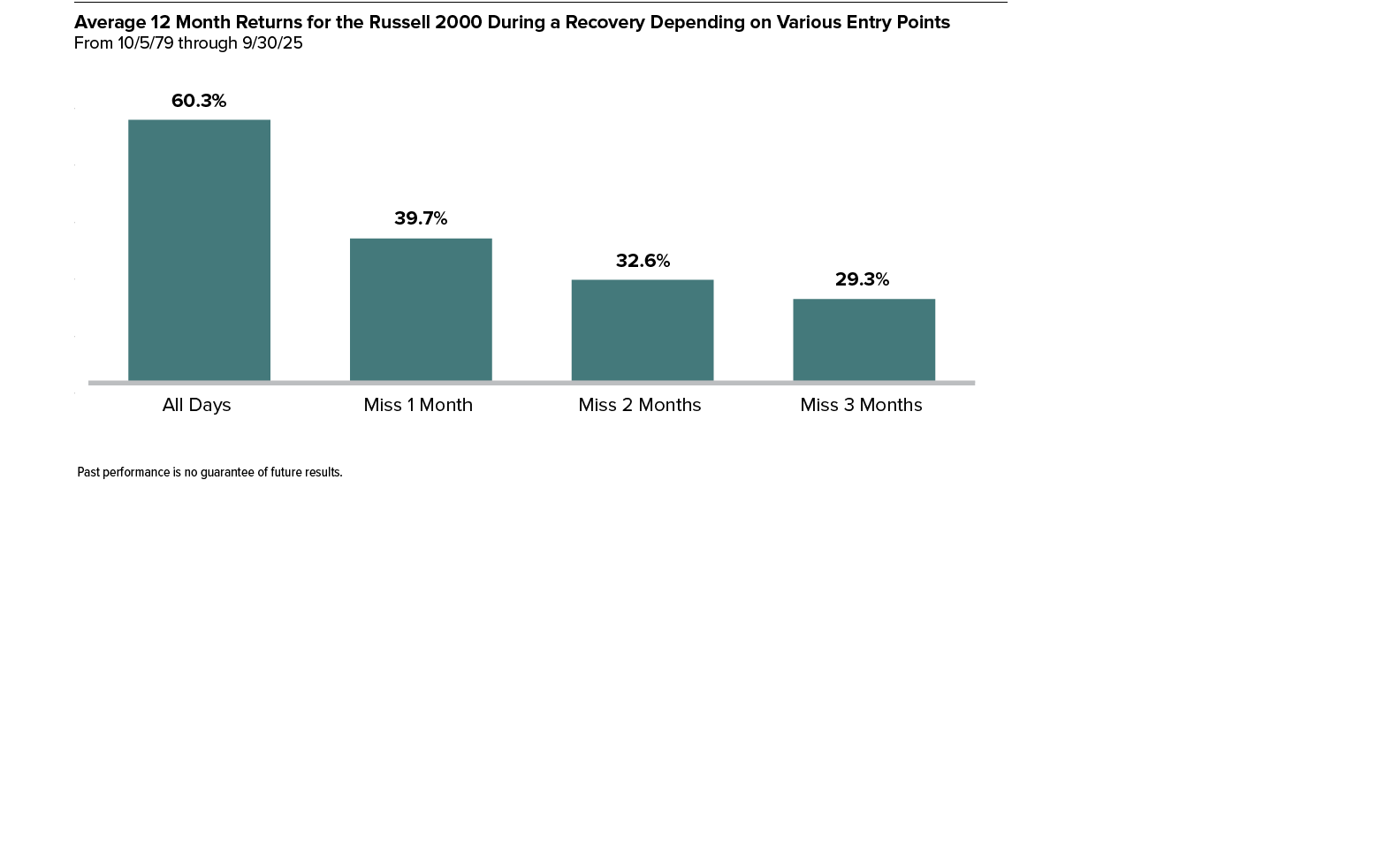
Small-Cap’s Estimated Earnings Growth is Expected to Be Higher Than Large-Cap’s in 2025
Consensus EPS estimates for the Russell 2000 are considerably higher than they are for the Russell 1000 in 2025.


Average Expected Earnings Growth for 2025-2026
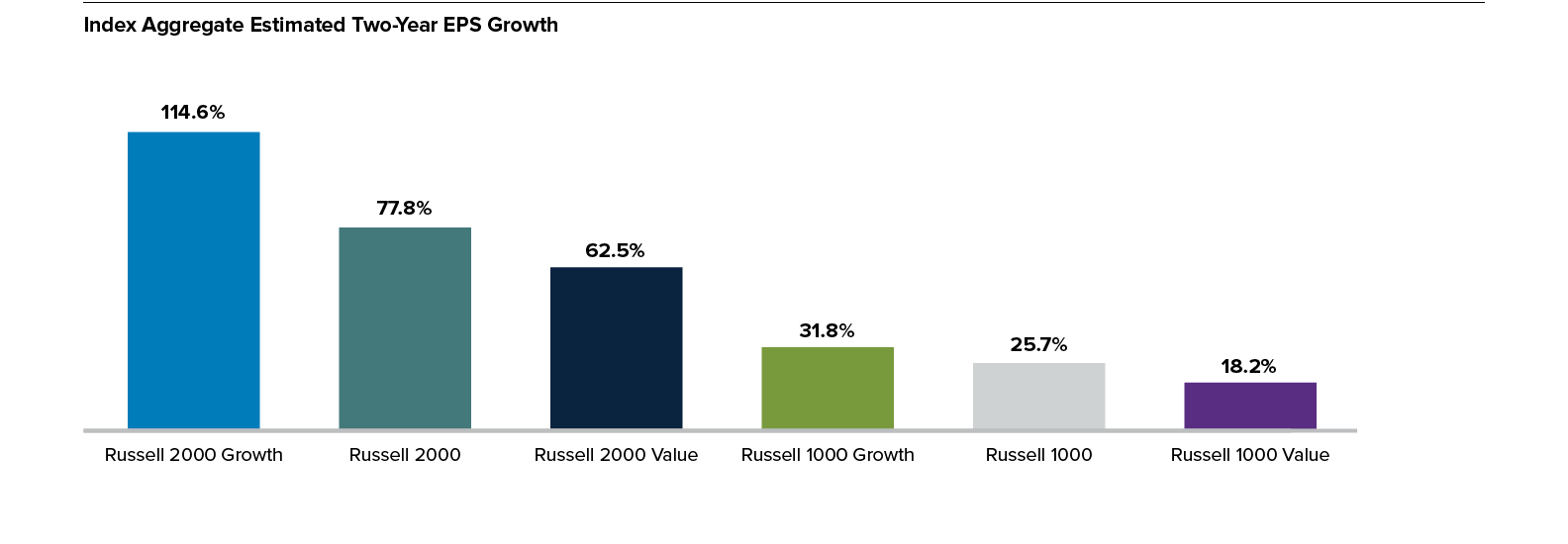

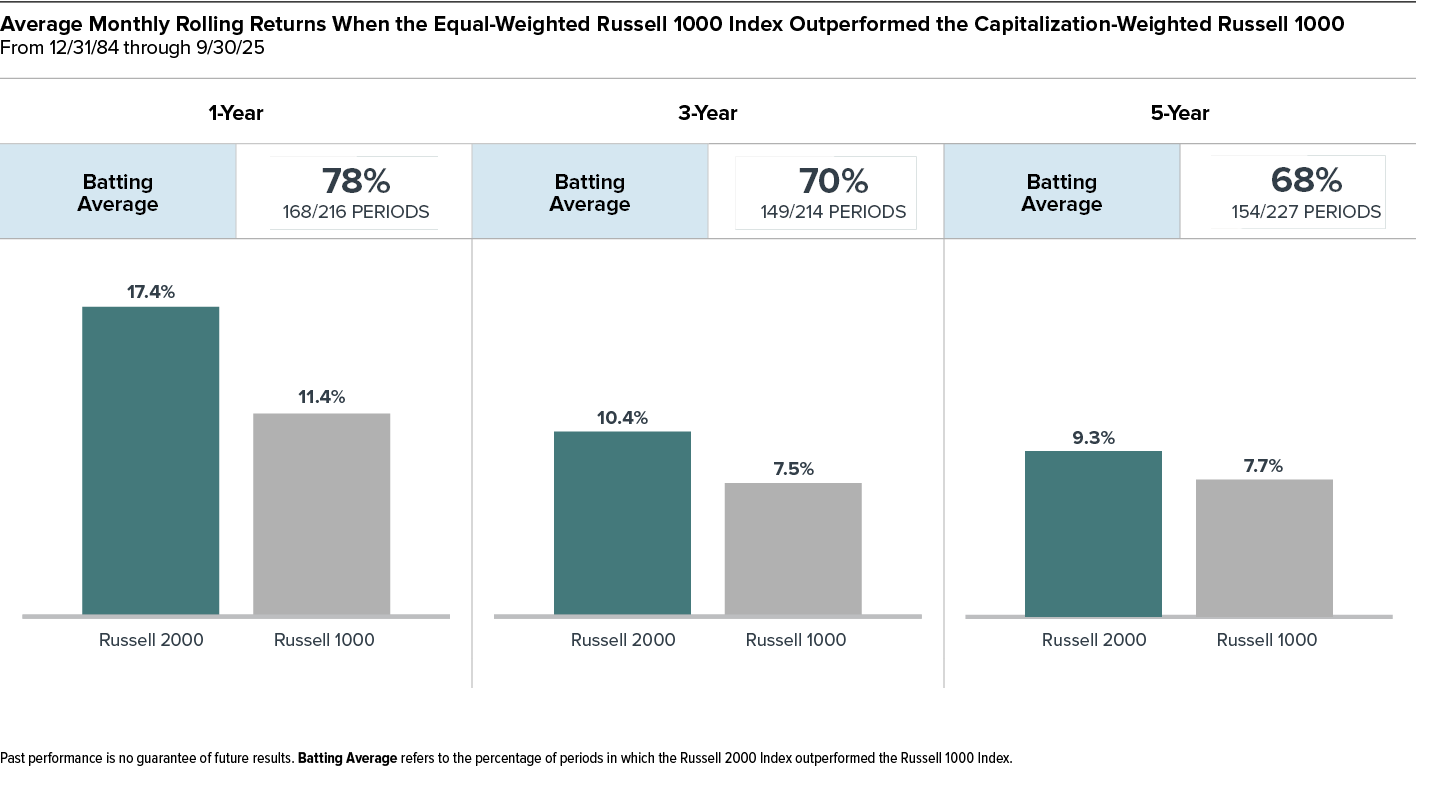
When the Equal-Weighted Russell 1000 Outperformed, Small-Cap Generally Led
Our research shows that when large-cap returns broaden, small-caps outperform. When the equal-weighted Russell 1000 beat the capitalization-weighted Russell 1000, the Russell 2000 outperformed the large-cap index over the majority of rolling 1-, 3-, and 5-year periods going back to 1984.
High-Quality and Low-Quality Small-Cap Stocks Have Historically Had Different Performance Profiles
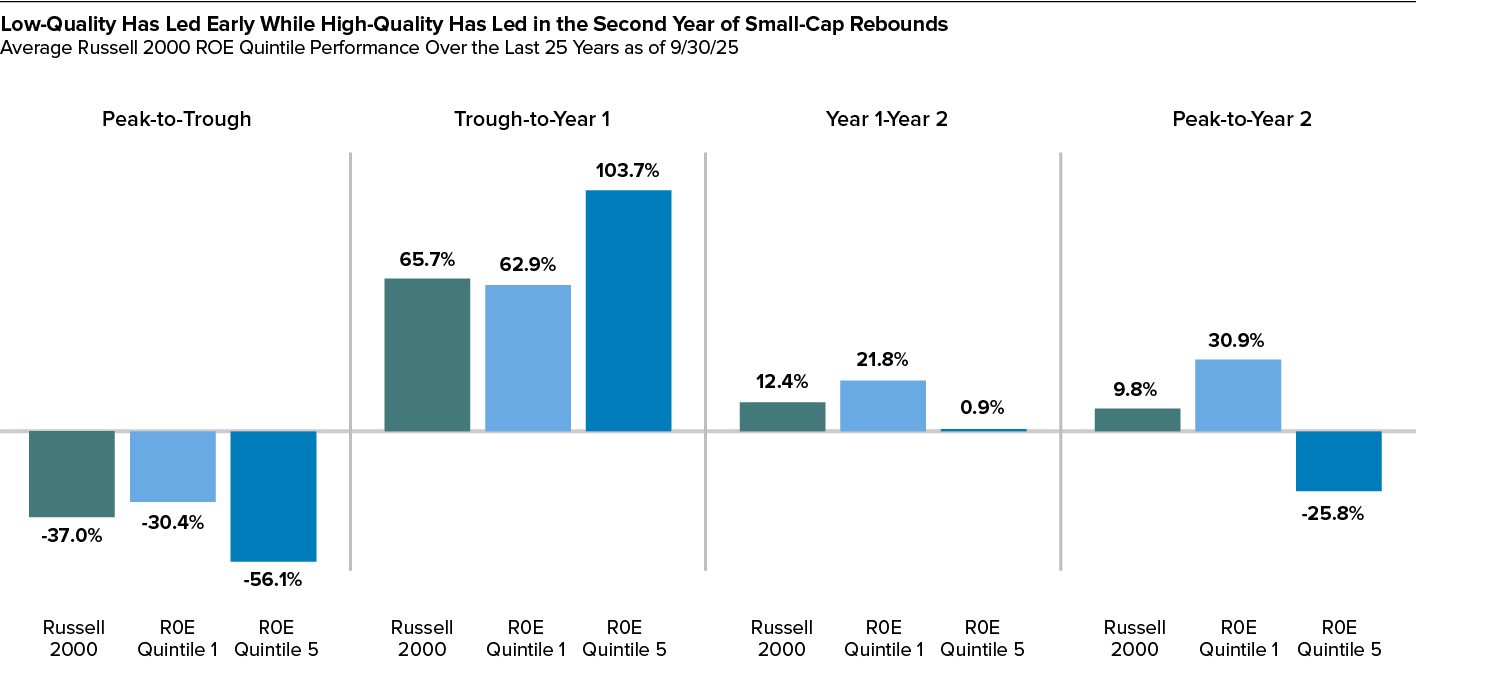

The performance data and trends outlined in this presentation are presented for illustrative purposes only. All performance information is presented on a total return basis and reflects the reinvestment of distributions. Past performance is no guarantee of future results. Historical market trends are not necessarily indicative of future market movements. The Russell 2000 Index is an unmanaged, capitalization-weighted index of domestic small-cap stocks. It measures the performance of the 2,000 smallest publicly traded U.S. companies in the Russell 3000 Index. The Russell 2000 Value and Growth indexes consist of the respective value and growth stocks within the Russell 2000 as determined by Russell Investments. The Russell 1000 index is an unmanaged, capitalization-weighted index of domestic large-cap stocks. It measures the performance of the 1,000 largest publicly traded U.S. companies in the Russell 3000 index. The Russell Top 50 Mega Cap Index is an unmanaged, capitalization-weighted index of domestic mega-cap stocks that measures the performance of the 50 largest publicly traded U.S. companies in the Russell 3000 index. The Russell Midcap Index measures the performance of the mid-cap segment of the U.S. equity universe. It includes approximately 800 of the smallest securities in the Russell 1000 Index. The Russell Midcap Value and Growth Indexes consist of the respective value and growth stocks within the Russell Midcap as determined by Russell Investments. The Russell 1000 index is an unmanaged, capitalization-weighted index of domestic large-cap stocks. It measures the performance of the 1,000 largest publicly traded U.S. companies in the Russell 3000 index. The Russell 1000 Value and Growth indexes consist of the respective value and growth stocks within the Russell 1000 as determined by Russell Investments. The Bloomberg Barclays US Aggregate Bond Index is an unmanaged, capitalization-weighted index of investment grade, US dollar-denominated, fixed-rate taxable bonds. Frank Russell Company (“Russell”) is the source and owner of the trademarks, service marks and copyrights related to the Russell Indexes. Russell® is a trademark of Frank Russell Company. Neither Russell nor its licensors accept any liability for any errors or omissions in the Russell Indexes and / or Russell ratings or underlying data and no party may rely on any Russell Indexes and / or Russell ratings and / or underlying data contained in this communication. No further distribution of Russell Data is permitted without Russell’s express written consent. Russell does not promote, sponsor or endorse the content of this communication. The S&P 500 is an index of U.S. large-cap stocks selected by Standard & Poor’s based on market size, liquidity, and industry grouping, among other factors, and includes reinvested dividends. The (Center for Research in Security Prices) CRSP (Center for Research in Security Pricing) equally divides the companies listed on the NYSE into 10 deciles based on market capitalization. Deciles 1-5 represent the largest domestic equity companies and Deciles 6-10 represent the smallest. CRSP then sorts all listed domestic equity companies based on these market cap ranges. By way of comparison, the CRSP 1-5 would have similar capitalization parameters to the S&P 500 and the CRSP 6-10 would have similar capitalization parameters to those of the Russell 2000. Index returns include net reinvested dividends and/or interest income. The performance of an index does not represent exactly any particular investment, as you cannot invest directly in an index. Royce & Associates, LP, the investment advisor of The Royce Fund and Royce Capital Fund, is a limited partnership organized under the laws of Delaware. Royce & Associates, LP primarily conducts its business under the name Royce Investment Partners.
Sector and industry weightings are determined using the Global Industry Classification Standard (“GICS”). GICS was developed by, and is the exclusive property of, Standard & Poor’s Financial Services LLC (“S&P”) and MSCI Inc. (“MSCI”). GICS is the trademark of S&P and MSCI. “Global Industry Classification Standard (GICS)” and “GICS Direct” are service marks of S&P and MSCI.

Notes, Performance and Risk Disclosure
One Madison Avenue | New York, NY 10010 | P (800) 348-1414 | www.royceinvest.com
Client Services Group | P (800) 33-ROYCE (800-337-6923)
